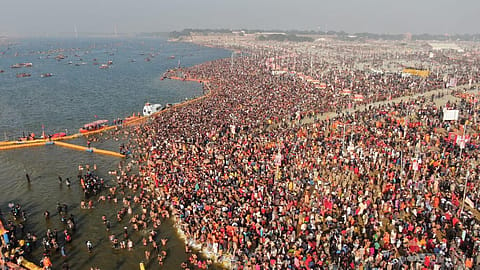87% flyers to Prayagraj for Mahakumbh say they paid 50-300% more airfare: Survey
It was not just airfares to and from Prayagraj that have risen sharply but also stay in hotels in the city and tents pitched near the ghats and the boat rides.

87% of air passengers who took a flight to Prayagraj for the ongoing Mahakumbh say they paid 50-300% more for the air ticket, according to a survey by LocalCircles. Only 13% of those who took a flight and surveyed stated that they did not pay a premium.
As the Mahakumbh draws to a close on February 26, LocalCircles conducted a nationwide survey to gather feedback from those who travelled to Mahakumbh about the charges they paid for air ticket, accommodation and transportation. The survey received over 49,000 responses from Mahakumbh travellers and located in 303 districts of India. 62% respondents were men while 38% respondents were women.
The survey asked those travelled by air to Prayagraj, “When you or your family members went to Mahakumbh, how much more did you pay than regular prices for air tickets?” Out of 16,215 who responded to the question only 13% stated that they “did not pay additional, just regular airfare”; 38% of respondents however stated that they “paid 50-100% more than regular fare”; 12% of respondents stated they “paid 100-200% more than regular fare”; 12% said they “paid 200-300% more than regular fare” and 25% of respondents stated they “paid over 300% more than regular fare”.
It was not just airfares to and from Prayagraj that have risen sharply but also stay in hotels in the city and tents pitched near the ghats and the boat rides. The survey asked people who have recently visited Mahakumbh, “When you or your family members went to Mahakumbh, how much more did you pay than regular prices for accommodation like tents, hotel rooms, lodges, etc.?” Out of 16,549 who responded to the question 26% stated they “did not pay additional, just regular rate”. However, 14% of respondents stated they “paid up to 50% more than regular rate”; 14% of respondents stated they “paid 50-100% more than regular rate”; 7% of respondents stated they “paid 100-200% more than regular rate”; 14% of respondents said they “paid 200-300% more than regular rate”; 18% said they “paid over 300% more than regular rate” and 7% of respondents did not give a clear answer.
66% of those who visited Mahakumbh and availed of local transportation services, boat ride etc. and surveyed confirm paying 50-300% over the regular rate.
The hike in prices was most during the auspicious days when thousands surge to take a holy dip in Sangam. For instance, during Mauni Amavasya in Maha Kumbh on January 29, the accommodation costs surged dramatically. Private tents and hotels increased their rates nearly threefold, raising concerns about affordability for pilgrims. Hotel rates, which had already gone up because of Kumbh from ₹2,500-3,000 to the range of ₹6,000 to ₹7,000, spiked further to over ₹22,000 for Mauni Amavasya, Basant Panchami Snan or Maghi Purnima Snan. Similarly, private tent rentals rose from ₹15,000 to a staggering ₹45,000 per night. For those seeking a luxurious stay, a special luxury cottage for three nights cost ₹2.40 lakh, while the accommodation in Dome City costs up to ₹91,000.
This comes days after MP Pramod Tiwari drew attention to the exorbitant airfares charged for travel to Prayagraj in the Parliament. Accusing airline operators of exploiting religious sentiments for profit, Tiwari argued that these prices effectively amount to “looting” the public under the guise of faith and tradition. The MP noted that the fare from Chennai to Prayagraj stands at ₹53,000, a round-trip between Kolkata and Prayagraj are priced at ₹35,000, while fares from Hyderabad, Delhi and Mumbai have soared to ₹47,500. Tiwari challenged Civil Aviation Minister Ram Mohan Naidu’s contention in parliament that the high airfares were purely “demand-driven”.